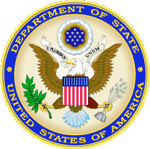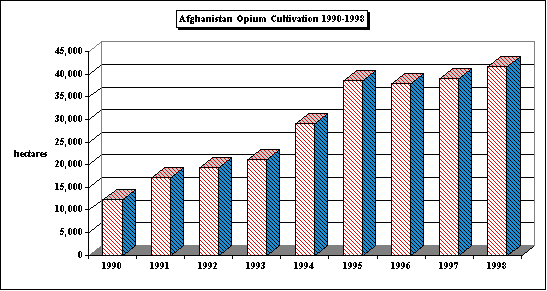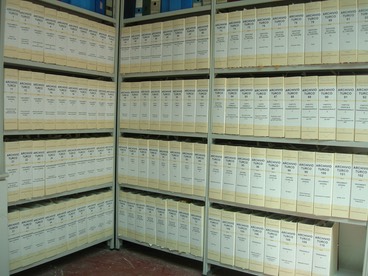www.state.gov/www/global/narcotics_law/1998_narc_report/swasi98.html

US. DEPARTMENT OF STATE
International Narcotics Control Strategy Report, 1998
Released by the Bureau for International Narcotics and Law Enforcement Affairs, U.S. Department of State - Washington, DC, March 1999
AFGHANISTAN
I. Summary
According to USG estimates, Afghanistan was the world's second largest producer of opium poppy in 1998. An estimated 1,350 metric tons (mts) of opium gum was produced from approximately 41,720 hectares (ha) of poppy. Poppy cultivation and opium gum production increased by 7 percent in 1998, despite poor weather. Afghanistan is a party to the 1988 UN Drug Convention, but neither of the warring political factions (Taliban or Northern Alliance) took steps to demonstrate that they take Afghanistan's obligations under the Convention seriously. By the end of the year, the Taliban faction controlled over 80 percent of Afghan territory. Aside from burning a reported one ton of opiates in Jalalabad in June, no action was taken to discourage poppy cultivation, destroy morphine or heroin laboratories, seize precursor chemicals or arrest and prosecute narcotics traffickers. Numerous reports indicated that all faction members continued to profit from the drug trade at all levels. Approximately 80 percent of the heroin consumed in Europe comes from Afghanistan.
II. Status of Country
In 1998, Afghanistan maintained its world ranking as the second largest producer of opium poppy. The Taliban and Northern Alliance military factions continued to be preoccupied with the internal struggle for the control of Afghanistan. By year's end, the Taliban controlled over 80 percent of the country's territory and over 95 percent of the area where opium poppy is cultivated. Heroin and morphine production at laboratories in Afghanistan requires large quantities of acetic anhydride produced primarily in Europe, China and India. Morphine and heroin exit Afghanistan along its porous borders with Pakistan, Iran, and the Central Asian Republics of Tajikistan, Turkmenistan and Uzbekistan. Apart from the corrupting influence on Afghan officials, drug production in Afghanistan had a destabilizing effect on its neighbors through the corruption of border guards and increasing heroin addiction. With the exception of Badakshan Province in the northeast, heroin addiction was not a problem in Afghanistan. Afghanistan is not a center for money laundering; financial institutions barely exist. There were reports, however, that private investment of the profits from drug trafficking accounted in some measure for a surge in building construction and other licit, commercial activity in Kandahar City during 1998. Afghanistan has not criminalized money laundering.
III. Country Actions Against Drugs in 1998
Policy Initiatives. Afghanistan's lack of a national government precluded formulation and implementation of a countrywide, counternarcotics policy in 1998. In addition, the political will of Afghan military factions and the capacity of their "governmental" structures to effectively carry out drug control efforts are weak at best. The Taliban appear to have adopted the policy that, unless they receive political recognition from the UN and from the international community and/or unless alternative development assistance is supplied to rural communities where poppy is cultivated, they will not honor international obligations regarding drug control. In past years, the Taliban admitted that consumption of "intoxicants," including opiates, is contrary to Islam and that, by extension, cultivation of opium poppy, the manufacture of morphine and heroin and trafficking in these drugs was in violation of Sharia law. In late 1997, during his visit to Kandahar, UNDCP Executive Director Arlacchi left a letter addressed to Taliban leader Mullah Omar asking the Taliban authorities to commit to 1) eliminating poppy where alternative development assistance was provided; 2) permitting UNDCP access to all poppy growing areas and allowing them to monitor enforcement of a poppy ban by the Taliban in any new areas of cultivation; 3) seizing and destroying drugs and precursor chemicals in the presence of UNDCP and 4) destroying laboratories and arresting those dealing in drugs. We understand the Taliban verbally agreed to UNDCP's points on the condition that UNDCP fulfill its alternative development commitment. However, in 1998, poppy cultivation increased and spread to new areas. At the time of the opium gum harvest in May, UNDCP informed the Taliban that poppy had been cultivated in new areas in the provinces of Laghman, Logar and Nangarhar. In response, the Taliban collected a reported ton of opium gum and burned it on June 1 at a public ceremony near the city of Jalalabad. They claimed that this represented the new poppy cultivation in the project area since the previous year. In an unverified policy statement issued by the High Commission for Drug Control in September 1998, the Taliban indicated that they would not support a strategy of forced eradication if farmers who benefited from alternative development failed to comply with the requirement to abandon poppy cultivation.
Accomplishments. No major drug control objectives were achieved in 1998. The potential to make progress through the UNDCP program deteriorated as the year advanced. From August 1998 until the end of the year, implementation of UNDCP's pilot alternative development/poppy reduction projects in Nangarhar and Kandahar Provinces was crippled by the removal of expatriate staff for security reasons. Also, from March 1998 to June 1998, expatriates were removed from many projects as the result of the mistreatment of a UN staffer by a Taliban official. Some donors criticized UNDCP for failing to consider human rights and gender issues in its programs. Although UNDCP's projects from the beginning had components addressing these issues, the criticism caused delay and the redesign of the projects, costing time and money. The Taliban grew frustrated with the slow pace of implementation of alternative development schemes and funded the rehabilitation of two factories in Kandahar Province themselves. They contrasted the small amount of money being spent by UNDCP on development schemes with what they considered inordinate sums consumed by UNDCP's operational expenses. In June, relations between the Taliban and UNDCP were severely strained because the Taliban were not invited to participate in the UN General Assembly's Special Session on Drugs. Afghanistan was represented at that meeting by the former Rabbani Government (now a member of the Northern Alliance) which had been ousted from Afghanistan's capital in September 1996 by the Taliban. By the end of November, however, there were signs that relations with UNDCP were mending. A USG-sponsored poppy eradication/alternative development program in Helmand Province through Mercy Corps International (MCI), an American NGO, continued this year. It is the only poppy reduction project being implemented by an NGO in Afghanistan. MCI accomplished all but one of its objectives during the year. The one objective not accomplished - to distribute a certain quantity of fruit trees to farmers - was not met due to rainy weather. The trees were held for the next planting season. The USG strongly supports the UN Special Mission to Afghanistan and its efforts to achieve peace and facilitate the development of a broad-based government that respects international norms of behavior on narcotics, human rights and terrorism. The Afghan Support Group (ASG) of major donors met twice during the year. At the meeting in Tokyo in December, it endorsed the principle that drugs are a cross-cutting issue and should be integrated wherever possible with other programs in Afghanistan. UNDCP agreed to include gender and human rights components in its counter-narcotics programs wherever appropriate.
Law Enforcement. Apart from the destruction of a reported ton of opium, there were no verified instances in which narcotics or precursor chemicals were seized or destroyed. There were no reports that drug traffickers or local drug dealers were arrested or prosecuted. And, there was no verified destruction of morphine or heroin laboratories. The Governor of Helmand claimed, however, to have destroyed laboratories in southern Helmand Province in May. He was encouraged to permit outside verification of such activity in the future. According to UNDCP, in November, the head of the Taliban's State High Commission for Drug Control responded to a request from the International Narcotics Control Board to investigate the authenticity of consignees in Afghanistan for an acetic anhydride shipment seized in India. The official investigated and advised that the addressees were fictitious. This is believed to be the first instance in which the Taliban have cooperated with an international narcotics investigation. As a result of UNDCP's efforts, Drug Control and Coordination Units (DCCUs) remained functional in Kandahar City, Jalalabad and Kabul. The DCCUs served as a liaison between Taliban authorities and the international community on drug control issues and assisted with implementation of UNDCP projects. The DCCUs operate under the High Commission for Drug Control, which is headquartered in Kabul and is responsible for planning, coordinating and implementing Taliban drug control policies. In August, the High Commission began publishing an English-language newsletter, entitled "Mukhaddarat" (narcotics). It provided policy statements and discussed narcotics issues. The publication was distributed to other embassies by the Afghan "Embassy" in Islamabad.
Corruption. Numerous reports indicated that both Taliban and Northern Alliance officials received payments from drug traffickers to facilitate the shipment of heroin and morphine through Afghanistan. As a matter of policy, the Taliban continued to condemn drug cultivation, production, trafficking and consumption. However, the drug business probably represents the largest sector of the economy. Opium poppy is Afghanistan's principal cash crop. Drug activities also provide a significant source of revenue for the Taliban movement. The practice of collecting a road tax at checkposts on the value of goods being transported is believed to be widespread. That tax is applied to drugs, just as it is for any other goods being shipped. There were also credible reports that Taliban officials collected fees to permit the unhindered operation of laboratories. In late 1997, a fairly high-ranking Taliban official acknowledged that local Mullahs (religious leaders) collect a 10 percent religious tax called "usher" on the opium crop produced by farmers. It was explained that this tax has always been collected on all agricultural products. In 1998, it was further learned that local Mullahs collect the tax in opium gum which is then sold by them to the same drug traders who buy the opium from the farmers.
Agreements and Treaties. Afghanistan is a party to the 1988 UN Drug Convention. Neither of the warring factions in Afghanistan have demonstrated a commitment to implement the Convention, however.
Cultivation/Production. Afghanistan is a major producer of both opium and hashish. Figures for cannabis cultivation are unavailable. By USG estimates, Afghanistan produced 1,350 MT of opium gum in 1998, compared to 1,265 MT in 1997. Opium poppy cultivation increased from 39,150 HA in 1997, to 41,720 HA in 1998, representing a seven percent increase. Helmand province continued to dominate cultivation with 22,970 HA, compared to the next largest producer, Nangarhar Province, with 8,860 HA. According to USG data, cultivation increased in 1998 in Helmand,--although it decreased in the Mercy Corps project area--Nangarhar and Oruzgan Provinces and fell slightly in Kandahar Province. According to UNDCP, Laghman and Logar provinces began cultivating poppies in 1998 for the first time. In both Nangarhar and Badakshan provinces, poppy cultivation emerged in one additional district. The poppy growing season for most of Afghanistan begins in October/November and ends by May/June. In order for alternative development/poppy reduction projects to induce farmers not to sow poppy, farmers must be convinced by the beginning of the sowing season that sufficient resources are being made available for them to be able to substitute a licit crop. By October/November 1997, poppy reduction projects had not been sufficiently implemented to achieve a positive reaction from farmers. However, implementation of UNDCP and Mercy Corps International (MCI) projects advanced sufficiently in certain districts of Nangarhar and Helmand Provinces during 1998 to permit the expectation that farmers will respond by substantially reducing poppy sown in those areas during October/November 1998. For the 1998/1999 growing year, UNDCP expects a 25 percent reduction in poppy cultivation in Shinwar District of Nangarhar, and MCI anticipates a 50 to 80 percent reduction along the Boghra Canal in central Helmand. UNDCP's poppy reduction projects in three districts of Kandahar Province are unlikely to produce results until the 1999 - 2000 poppy growing season. But, by the 1999 - 2000 poppy growing season, Shinwar District should be free of poppy.
Drug Flow/Transit. Heroin and morphine base are trafficked across Afghanistan's borders to Pakistan, Turkmenistan, Tajikistan, Uzbekistan, and Iran. Although opiates from Afghanistan are consumed in these neighboring countries and in India, the primary destination is Europe (approximately 80 percent), followed by North America. During 1998, a strong Iranian interdiction campaign and border tensions between Iran and Afghanistan probably meant an increased volume of trafficking via Pakistan and the Central Asian republics. Large quantities of precursor chemicals, particularly acetic anhydride (AA), reportedly enter Afghanistan from Central Asia, Europe and India.
Demand Reduction. Addiction to opiates is a serious problem only in Badakshan Province, which is under the control of the Northern Alliance. In 1998, provincial authorities there indicated that they planned to strengthen the capacity of drug treatment facilities, but that a shortage of funds would limit this activity. UNDCP initiated several public education campaigns during the year in Afghanistan.
IV. U.S. Policy Initiatives and Programs
The USG continued to urge the Afghan factions to demonstrate that they take international drug control obligations seriously. Taliban officials were told repeatedly that, if they wanted to be recognized as a member of the international community, they needed to show that they could conduct themselves in a responsible manner with respect to drug control, human rights and terrorism. The U.S. strongly supported UNDCP's efforts to engage the Taliban and local communities in counternarcotics activities. USG contributions to UNDCP in FY-98 totaled $500,000. Unfortunately, UNDCP's ability to make a sustained effort this year was undermined by events which were largely beyond its control. Intense fighting in northern Afghanistan precluded UNDCP from undertaking projects there. From August until the end of the year, all UN expatriate staff were prohibited from entering Afghanistan due to the deteriorated security situation. The USG agreed to provide $1 million in additional funding for the MCI poppy reduction program in Helmand Province in FY 1999. The focus of the program is rehabilitation of the Boghra Canal, repair of underground irrigation channels and crop substitution. In 1998, farmers committed to abandoning poppy cultivation when they can off-set the loss in poppy income by being able to grow or expand summer crops or grow higher value crops which require a year-round water supply. Currently, in most areas of the MCI program, farmers must rely on a winter crop which is rain-fed. These crops are principally poppy and wheat. To the extent that poppy continues to displace wheat in the country as a whole, Afghanistan suffers from an increasing food shortage since wheat produces the flat bread that is the staple of the Afghan diet. In early May, a Drug Enforcement Administration (DEA) officer from Peshawar visited Kabul and met with officials from the State High Commission for Drug Control and officers from a variety of other law enforcement entities in Afghanistan. During the meeting, DEA discussed counter-drug operations and exposed the Afghans to some new approaches to the problem which could be effective in Afghanistan. The visit received widespread support and publicity in Kabul. Road Ahead. The USG will continue to impress upon Taliban officials the importance we attach to unconditional counter-drug measures by them. The USG will also continue to support UNDCP's efforts in Afghanistan provided they are tied to measurable counternarcotics objectives, are community based and aid women. We expect the ASG process to result in the introduction of anti-narcotics requirements in all appropriate development aid projects in Afghanistan. In 1999, the MCI program and UNDCP's poppy reduction projects will be viewed as a test to determine future viability of this type of funding activity. DEA does not recommend further international training seminars at this time.
Statistical Tables |
||||||||||||||||||||||||||||||||
TABLES for CY |
|
|
1998 |
1997 |
1996 |
1995 |
1994 |
1993 |
1992 |
1991 |
1990 |
|||||||||||||||||||||
OPIUM |
|
|
|
|
|
|
|
|
|
|
|
|||||||||||||||||||||
|
Potentially Harvestable |
[ha] |
41,720 |
39,150 |
37,950 |
38,740 |
29,180 |
21,080 |
19,470 |
17,190 |
12,370 |
|||||||||||||||||||||
|
Eradication |
[ha] |
- |
- |
- |
- |
- |
- |
- |
- |
- |
|||||||||||||||||||||
|
Cultivation |
[ha] |
41,720 |
39,150 |
37,950 |
38,740 |
29,180 |
21,080 |
19,470 |
17,190 |
12,370 |
|||||||||||||||||||||
|
Potential Yield* |
[mt] |
1,350 |
1,265 |
1,230 |
1,250 |
950 |
685 |
640 |
570 |
415 |
|||||||||||||||||||||
Refining, Seizures and Arrests /a |
|
|
|
|
|
|
|
|
|
|
|
|||||||||||||||||||||
(a) |
No information concerning heroin or hashish refining, or drug seizures and arrests, is available |
|||||||||||||||||||||||||||||||
* |
DEA believes, based upon foreign reporting and human sources, that opium production in Afghanistan may have exceeded 900 mt in 1992 and 1993. |
|||||||||||||||||||||||||||||||

Last Updated on 2/26/99


